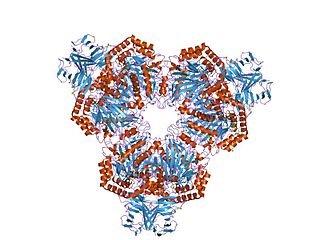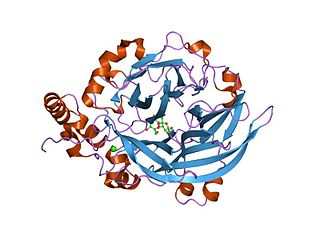Related Research Articles

In molecular biology, Glycoside hydrolase family 12 is a family of glycoside hydrolases.

In molecular biology, Glycoside hydrolase family 17 is a family of glycoside hydrolases. It folds into a TIM barrel.

In molecular biology, glycoside hydrolase family 31 is a family of glycoside hydrolases.

In molecular biology, glycoside hydrolase family 4 is a family of glycoside hydrolases EC 3.2.1., which are a widespread group of enzymes that hydrolyse the glycosidic bond between two or more carbohydrates, or between a carbohydrate and a non-carbohydrate moiety. A classification system for glycoside hydrolases, based on sequence similarity, has led to the definition of >100 different families. This classification is available on the CAZy web site, and also discussed at CAZypedia, an online encyclopedia of carbohydrate active enzymes.
In molecular biology, glycoside hydrolase family 43 is a family of glycoside hydrolases.

In molecular biology, glycoside hydrolase family 49 is a family of glycoside hydrolases.
In molecular biology, glycoside hydrolase family 62 is a family of glycoside hydrolases.

In molecular biology, glycoside hydrolase family 68 is a family of glycoside hydrolases.
In molecular biology, glycoside hydrolase family 76 is a family of glycoside hydrolases.

In molecular biology, glycoside hydrolase family 77 is a family of glycoside hydrolases.
In molecular biology, glycoside hydrolase family 81 is a family of glycoside hydrolases.
In molecular biology, glycoside hydrolase family 92 is a family of glycoside hydrolases.
In molecular biology, glycoside hydrolase family 9 is a family of glycoside hydrolases.
In molecular biology, glycoside hydrolase family 8 is a family of glycoside hydrolases EC 3.2.1., which are a widespread group of enzymes that hydrolyse the glycosidic bond between two or more carbohydrates, or between a carbohydrate and a non-carbohydrate moiety. A classification system for glycoside hydrolases, based on sequence similarity, has led to the definition of >100 different families. This classification is available on the CAZy website, and also discussed at CAZypedia, an online encyclopedia of carbohydrate-active enzymes.

In molecular biology, glycoside hydrolase family 13 is a family of glycoside hydrolases.
In molecular biology, glycoside hydrolase family 15 is a family of glycoside hydrolases.
In molecular biology, glycoside hydrolase family 37 is a family of glycoside hydrolases.
In molecular biology, glycoside hydrolase family 47 is a family of glycoside hydrolases.
In molecular biology, glycoside hydrolase family 57 is a family of glycoside hydrolases.
In molecular biology, glycoside hydrolase family 100 is a family of glycoside hydrolases.
References
- ↑ Henrissat B, Callebaut I, Fabrega S, Lehn P, Mornon JP, Davies G (July 1995). "Conserved catalytic machinery and the prediction of a common fold for several families of glycosyl hydrolases". Proceedings of the National Academy of Sciences of the United States of America. 92 (15): 7090–4. Bibcode:1995PNAS...92.7090H. doi: 10.1073/pnas.92.15.7090 . PMC 41477 . PMID 7624375.
- ↑ Davies G, Henrissat B (September 1995). "Structures and mechanisms of glycosyl hydrolases". Structure. 3 (9): 853–9. doi: 10.1016/S0969-2126(01)00220-9 . PMID 8535779.
- ↑ Henrissat B, Bairoch A (June 1996). "Updating the sequence-based classification of glycosyl hydrolases". The Biochemical Journal. 316 (Pt 2): 695–6. doi:10.1042/bj3160695. PMC 1217404 . PMID 8687420.
- ↑ "Home". CAZy.org. Retrieved 2018-03-06.
- ↑ Lombard V, Golaconda Ramulu H, Drula E, Coutinho PM, Henrissat B (January 2014). "The carbohydrate-active enzymes database (CAZy) in 2013". Nucleic Acids Research. 42 (Database issue): D490–5. doi:10.1093/nar/gkt1178. PMC 3965031 . PMID 24270786.
- ↑ "Glycoside Hydrolase Family 70". CAZypedia.org. Retrieved 2018-03-06.
- ↑ CAZypedia Consortium (December 2018). "Ten years of CAZypedia: a living encyclopedia of carbohydrate-active enzymes" (PDF). Glycobiology. 28 (1): 3–8. doi: 10.1093/glycob/cwx089 . PMID 29040563.
- ↑ Croux C, Monchois V, Willemot RM, Remaud-simeon M, Monsan P (1996). "Cloning and sequencing of a gene coding for a novel dextransucrase from Leuconostoc mesenteroides NRRL B-1299 synthesizing only alpha (1-6) and alpha (1-3) linkages". Gene. 182 (1–2): 23–32. doi:10.1016/S0378-1119(96)00443-X. PMID 8982063.